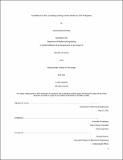| dc.contributor.advisor | Annaswamy, Anuradha | |
| dc.contributor.author | Shrestha, Swochchhanda | |
| dc.date.accessioned | 2022-01-14T14:53:46Z | |
| dc.date.available | 2022-01-14T14:53:46Z | |
| dc.date.issued | 2021-06 | |
| dc.date.submitted | 2021-06-15T16:17:53.054Z | |
| dc.identifier.uri | https://hdl.handle.net/1721.1/139161 | |
| dc.description.abstract | A literature review was performed to evaluate existing participation models for distributed energy resources (DERs), including those of both the demand response variety and the distributed generation variety (such as small-scale solar rooftop solar PV). This literature review consisted of both academic papers and public information from commercial DER aggregators. Through the literature review, DER participation models in different regions of the United States were determined. In some areas, such as New England, DERs can only participate independently as price-takers in the wholesale electricity market while other regions, such as California, allow DERs to actively bid into the wholesale electricity market through large-scale aggregators that represent many individual DERs.
Potential novel models for DER participation were also examined in the form of retail markets, which have been covered extensively in past work done by MIT’s Active Adaptive Control Lab. Under these proposed retail markets, a Distribution System Operator (DSO) coordinates energy transactions with local DERs while interfacing with the wholesale electricity market to maintain system reliability. Previous research on the topic of these novel retail markets suggests that they are well equipped for scheduling and responding to variations in DERs in real time.
DER participation models of the California Independent System Operator (CAISO) and the Independent System Operator – New England (ISO-NE) were modeled onto a 30-bus network, and simulated using historical data of load demand from each Independent System Operator. The performance of these models in key metrics of average cost paid per node and the uptake of DERs were compared to the same systems under a retail market using the IEEE 123-bus network. The simulation results suggest that existing models of DER participation are not as effective as the proposed retail market in these key metrics. | |
| dc.publisher | Massachusetts Institute of Technology | |
| dc.rights | In Copyright - Educational Use Permitted | |
| dc.rights | Copyright retained by author(s) | |
| dc.rights.uri | https://rightsstatements.org/page/InC-EDU/1.0/ | |
| dc.title | Possibilities for DERs: Evaluating Existing and New Models for DER Participation | |
| dc.type | Thesis | |
| dc.description.degree | S.B. | |
| dc.contributor.department | Massachusetts Institute of Technology. Department of Mechanical Engineering | |
| mit.thesis.degree | Bachelor | |
| thesis.degree.name | Bachelor of Science in Mechanical Engineering | |
